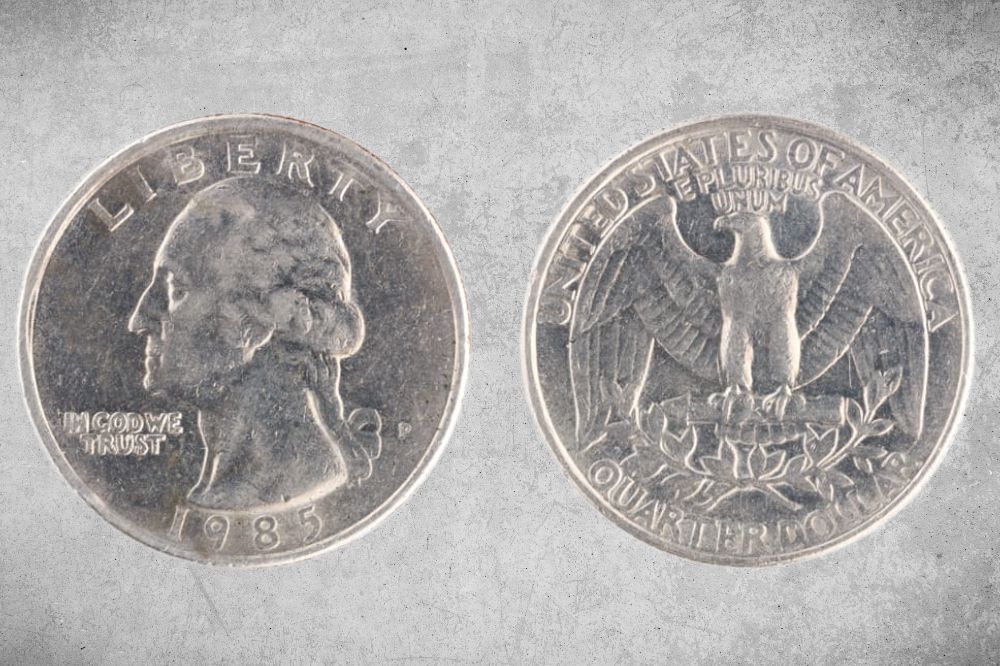A 1985 quarter may not be as old or rare, but it can pick up a pretty price in the auction house. This is especially true if you have a high-grade coin – or an erroneous one.
Now, if you have a roll of 1985 quarters, it’s time you checked every one of them. And, with the help of this value guide, you may be able to find a proverbial needle in the haystack!
1985 Quarter Details
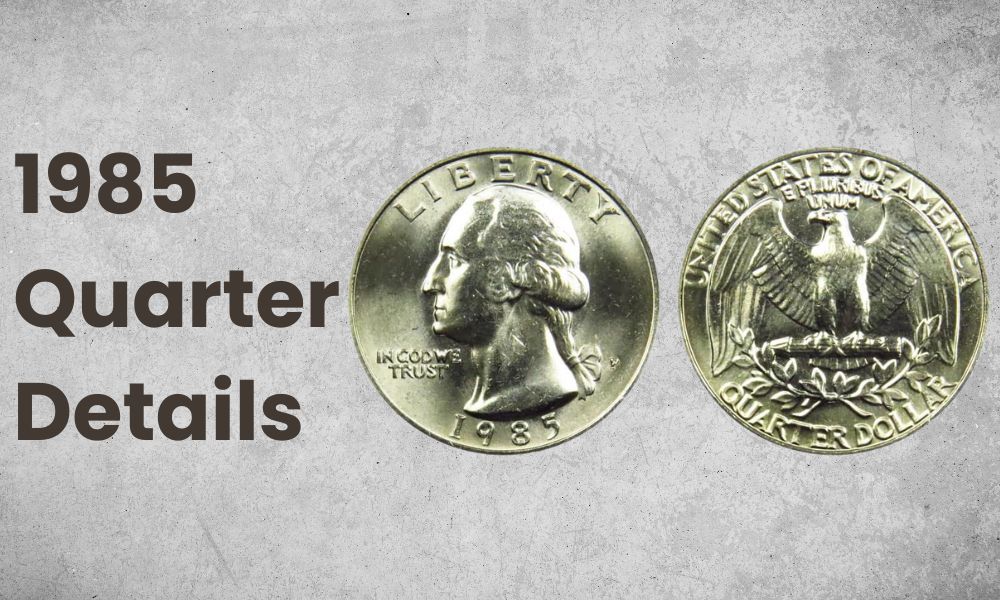
- Category: Washington Quarter
- Value:$0.25/25 cents
- Mintage: 775,818,962
- Minted at: Philadelphia
- Mint mark: P
- Strike type: Business
- Obverse Designer: John Flanagan
- Reverse Designer: John Flanagan
- Metal Composition: 67% Copper – 8.33% Nickel
- Diameter: 3 mm
- Mass / Weight: 67 grams
- Edge: Reeded
- Coinage years: 1965-1998
Also Read: Top 15 Most Valuable Quarters In Circulation
1985 Quarter Value Chart
| Mint Mark | Good | Fine | Extremely Fine | Uncirculated | Proof |
| 1985 P Quarter | $0.30 | $0.30 | $0.30 | $17 | n/a |
| 1985 D Quarter | $0.30 | $0.30 | $0.30 | $10 | n/a |
| 1985 S Quarter | n/a | n/a | n/a | n/a | $4.63 |
1985 Quarter Value and Varieties Guides
1985 quarters come in three varieties. Those released to the masses were minted in Philadelphia and Denver, while proof coins were struck in San Francisco.
Let’s discuss each one of them in detail.
1985 P Quarter
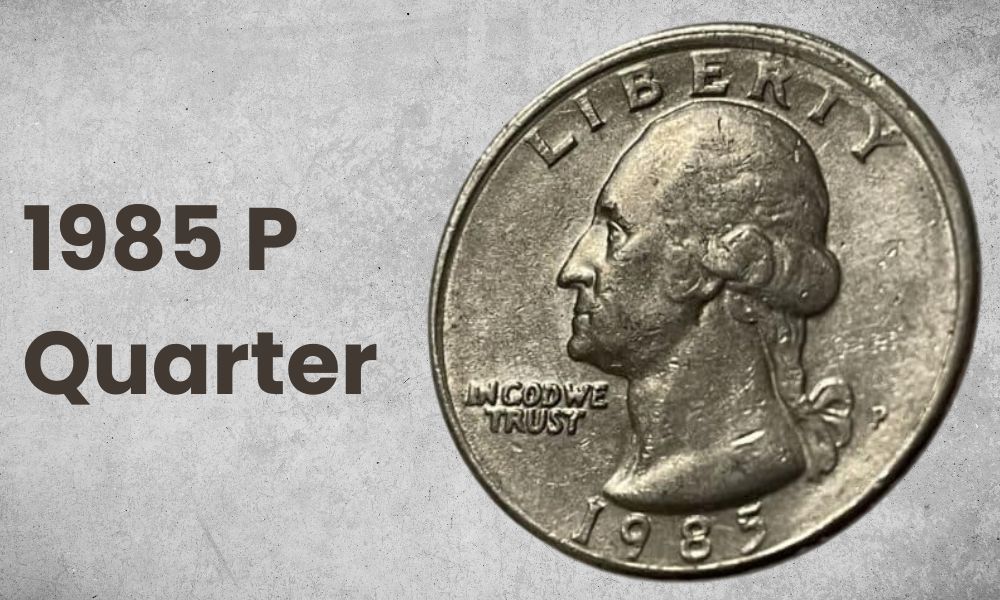
- Category: Washington Quarter
- Value:$0.25/25 cents
- Mintage: 775,818,962
- Minted at: Philadelphia
- Mint mark: P
- Strike type: Business
- Obverse Designer: John Flanagan
- Reverse Designer: John Flanagan
- Metal Composition: 67% Copper – 8.33% Nickel
- Diameter: 3 mm
- Mass / Weight: 67 grams
- Edge: Reeded
- Coinage years: 1965-1998
As with all Washington quarters, the 1985 25-cent coin features George Washington on its obverse. The design, created by John Flanagan, is based on the bust sculpted by Jean-Marie Houdon.
It is said that Houdon took the life mask of the president for his design. He then sculpted the bust from October 6 to 12 in Washington’s Mt. Vernon Estate.
Though Flanagan’s design largely took from Houdon’s bust, his style showed Washington with a larger roll of hair.
Apart from Washington’s image, the obverse also features the word “Liberty” on top and the motto “In God We Trust.” The year “1985” can be found on the bottom.
The 1985 P quarter is one of the coins from the Philadelphia mint to bear the ‘P’ mark, which you’ll find near Washington’s braids. In the years prior, currencies created in this location had no mint mark.
Due to the high mintage number of this coin, only gem-quality currencies can be sold for a considerable price. An MS 65 coin is worth $12, while an MS 66 coin is worth $45. Higher grades cost $285, although an MS 68 coin was once sold for $1,323.
1985 D Quarter
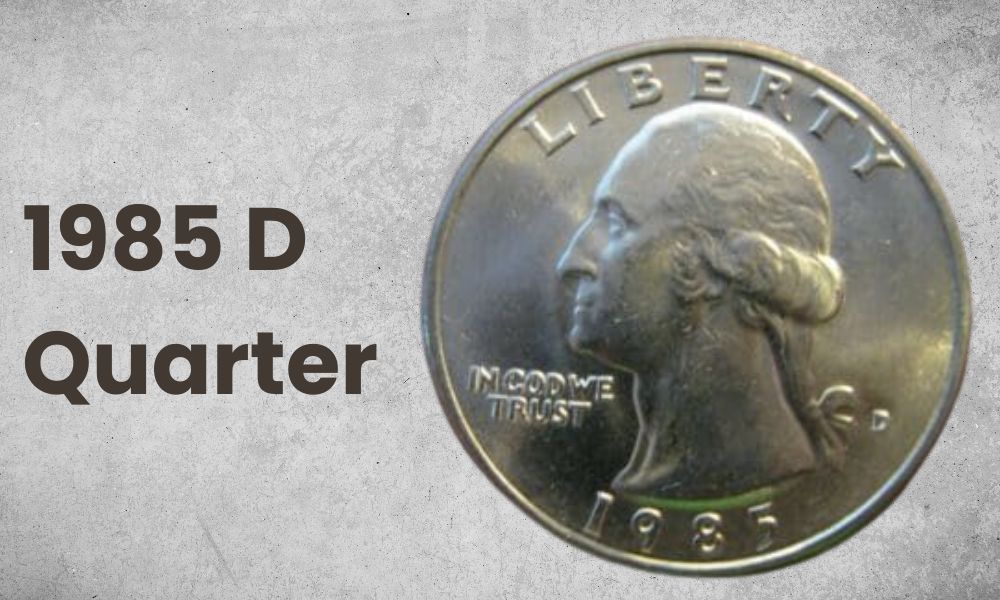
- Category: Washington Quarter
- Value:$0.25/25 cents
- Mintage: 519,962,888
- Minted at: Denver
- Mint mark: D
- Strike type: Business
- Obverse Designer: John Flanagan
- Reverse Designer: John Flanagan
- Metal Composition: 67% Copper – 8.33% Nickel
- Diameter: 3 mm
- Mass / Weight: 67 grams
- Edge: Reeded
- Coinage years: 1965-1998
1985 D quarters are produced in Denver, a location that produces both circulation coins and commemorative/mint coins. It first opened in 1897 and has been minting US currency ever since.
Just like the quarters minted in Philadelphia, D quarters have a high selling value. This is because fewer of them were produced (519 million vs. 775 million.)
MS 65 coins are worth $16, while MS 67 coins clock in at $550. Higher-grade coins have been known to sell for as much as $4,250.
1985 S Quarter
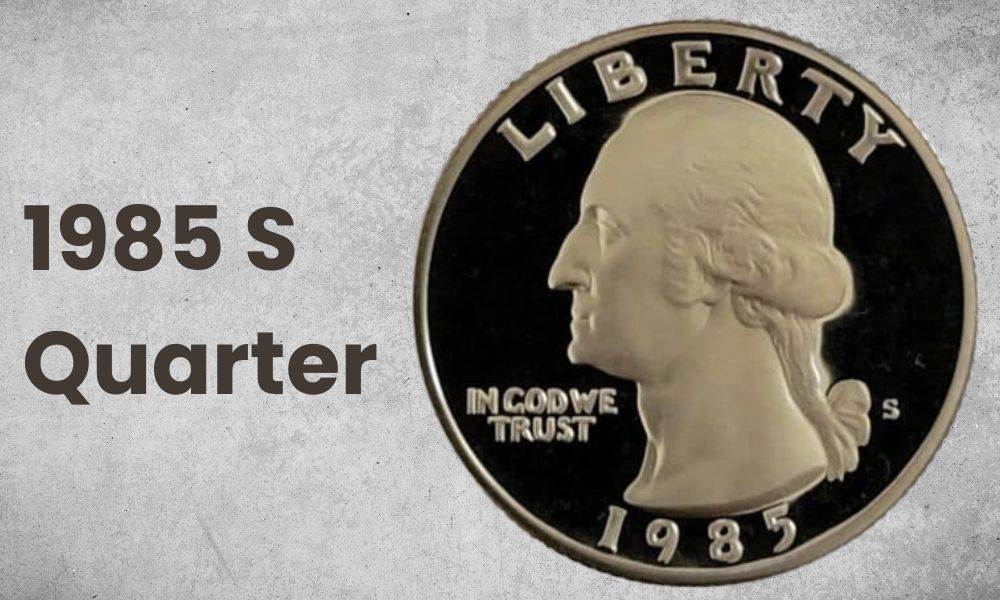
- Category: Washington Quarter
- Value:$0.25/25 cents
- Mintage: 3,362,821
- Minted at: San Francisco
- Mint mark: S
- Strike type: Business
- Obverse Designer: John Flanagan
- Reverse Designer: John Flanagan
- Metal Composition: 67% Copper – 8.33% Nickel
- Diameter: 3 mm
- Mass / Weight: 67 grams
- Edge: Reeded
- Coinage years: 1965-1998
The 1985 S quarter, as with all other currencies minted in San Francisco, are what you call proof coins. They’re made with special planchets and dies, which is why they show exceptional detail.
While most people would think that 1985 S quarters are worth more, it’s not always the case. Since these are proof coins marketed towards collectors, they’re well-preserved. This means they’re not hard to find, so their values are generally lower.
For example, a PR 61 coin is only worth $6, while a PR 69 deep cameo is only worth $16. A PR 70 deep cameo, meanwhile, costs about $50.
Also Read: Top 16 Most Valuable Modern Quarters Worth Money
1985 Quarter History
The 1985 quarter is what’s known as the Washington Quarter. And, as the name suggests, it features the image of George Washington, the first US president.
It replaced the Standing Liberty quarter, which was used from 1916 to 1930.
Design
The coin’s obverse image was created by John Flanagan, an accomplished coin designer and engraver.
Initially, Washington was going to be commemorated on the half-dollar. This special edition currency was supposed to run only in 1932, his 200th birth anniversary. Laura Gardin Fraser, the wife of Buffalo nickel designer James Earle Fraser, was selected to design this coin.
However, plans changed, and it was decided that Washington would go on the quarter instead.
With this shift in plans came a change in the designer as well. Treasury secretary Andrew W. Mellon preferred Flanagan’s design. So instead of using Fraser’s image, Flanagan ended up designing the commemorative coin.
Needless to say, Flanagan also created the reverse side of the coin.
The back part features the mighty eagle, which is perched on a bundle of arrows. An olive branch is also etched below. Truly contradictory, these images represent both war and peace.
Written on the top arc is “United States of America.” Below it is the motto “E Pluribus Unum,” which Benjamin Franklin, Thomas Jefferson, and John Adams wanted to include in the Great Seal in 1776.
The denomination “Quarter Dollar” is etched on the lower arc.
The 1985 quarter has a reeded edge, which is believed to reduce the coin’s value.
Composition
First minted in 1932 – or the founding father’s 200th birth anniversary – Washington quarters were initially made of 90% silver. But with the rising costs of silver, and the fact that people just hoarded the coins, the US mint decided to use a mixture of copper and nickel instead.
This meant that the 1985 quarter weighed lighter at 5.67 grams. Silver coins made prior were heavier at 6.25 grams.
Because the metal composition was changed, the design had to be revised too. In the 1960s, the higher relief design was brought down a little so all the details could be struck on the coin.
The design was further sharpened in 1974, and several other alterations were done in the next two decades.
Since 1999, Washington quarters have been featuring the following on the reverse:
- 50 states
- District of Columbia and other US territories
- National Parks/Forests (America the Beautiful edition)
- American women
Also Read: Top 15 Most Valuable Quarters In Circulation
1985 Quarter Grading
The 1985 quarter, as with other coins, is graded according to a 70-point scale. Known as the Sheldon Scale, it categorizes coins as:
- Poor
- Fair
- Good
- Very Good
- Fine
- Very Fine
- Extremely Fine
- About Uncirculated
- Mint State (Basal, Acceptable, Choice, Premium Quality, Almost Perfect, or Perfect)
Of course, the higher the coin grade, the higher the value.
Lists of 1985 Quarter Errors
Errors make 1985 quarters more valuable than ever. So if your coin feels off, have it appraised, for it might bear any of these mistakes:
1. 1985 Quarter Double Strike Error
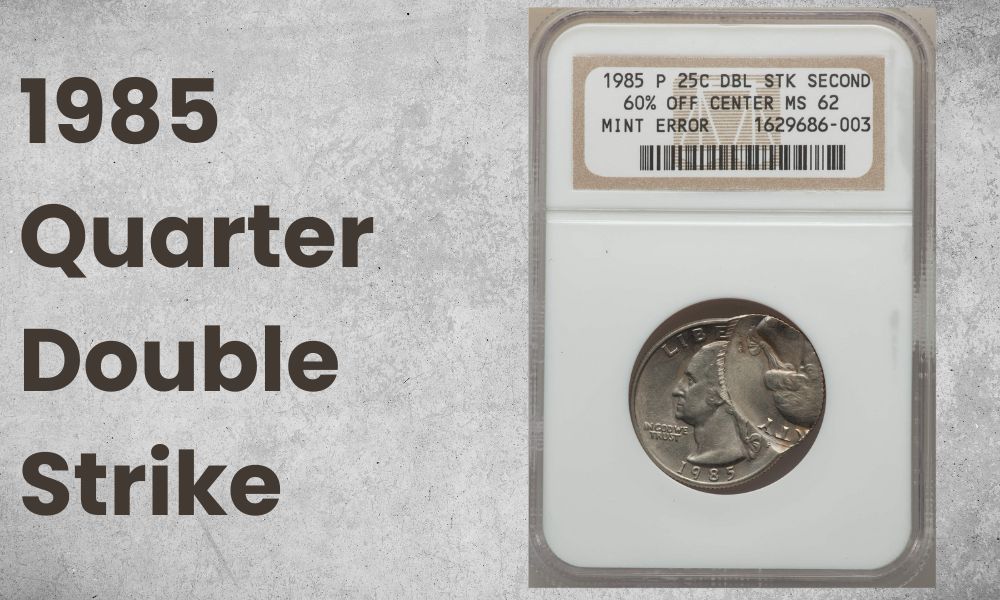
When the coin isn’t removed from the press after it has been imprinted, it will be struck again. This is what experts call the double-struck error.
This mistake can occur with other error types, so values can vary. For example, a double-struck coin with an off-center second strike has been sold for $190 to $250. A coin with both strikes that are off-center fetched more at $280.
2. 1985 Quarter Multi-Strike Error
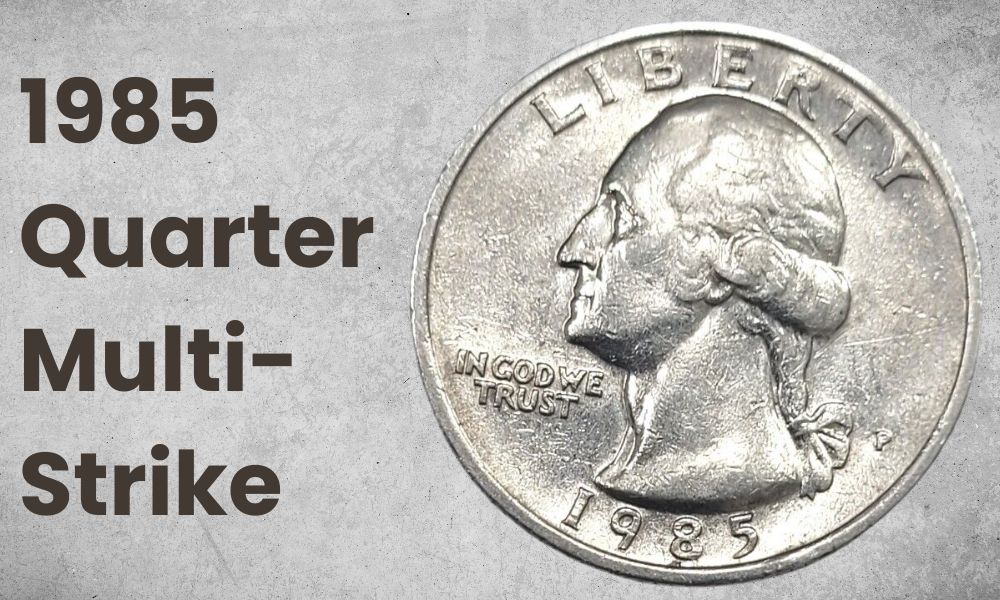
If a coin isn’t ejected from a press, it can be struck multiple times. This gives the coin a somewhat messy look.
However, this disheveled look makes this coin popular and valuable. In fact, a quarter with this error has been sold for a reasonable $800 at an auction.
3. 1985 Quarter Mated Pair Error
A mated pair error occurs during the striking process.
In an example in the above video, one coin received a centered blow – but it wasn’t ejected from the press. The second planchet partly entered the press, so part of it was below the previously-struck coin. They were then struck together, thus giving them their distinctive errors.
This coin was sold at auction for $1,725.
4. 1985 Quarter Double Die Error
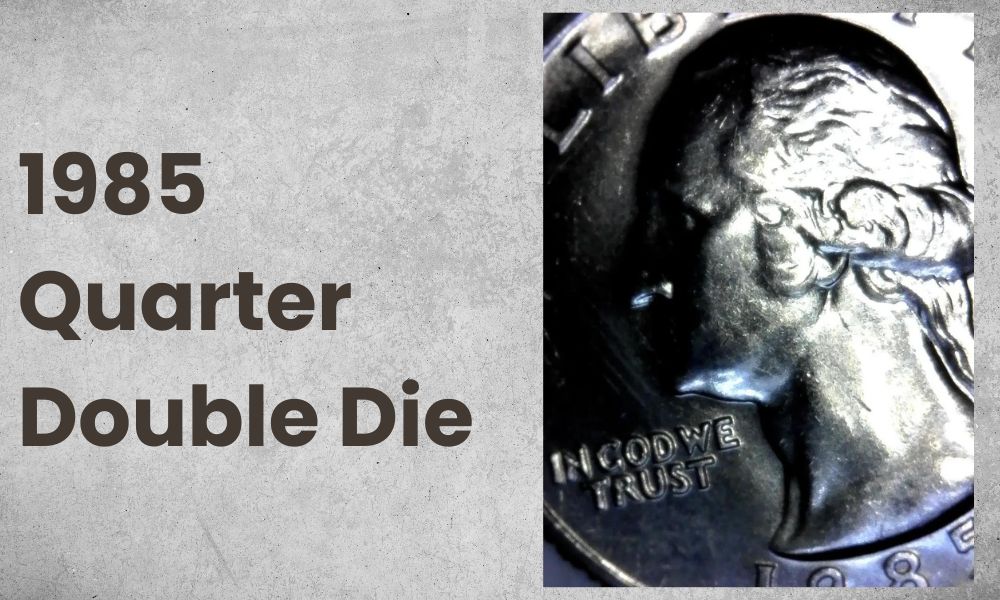
A double die error occurs during the hubbing process. The die design is mistakenly doubled, thus creating a ‘doubling’ effect.
For example, one 1985 quarter had the word “United” doubled, while the letters S, T, and A in “States” were also doubled.
Doubling was also seen on the letters E, P, and U in “Et Pluribus Unum,” as well as the N and TRUST in “In God We Trust.”
5. 1985 Quarter Struck on a Five-Cent Planchet Error
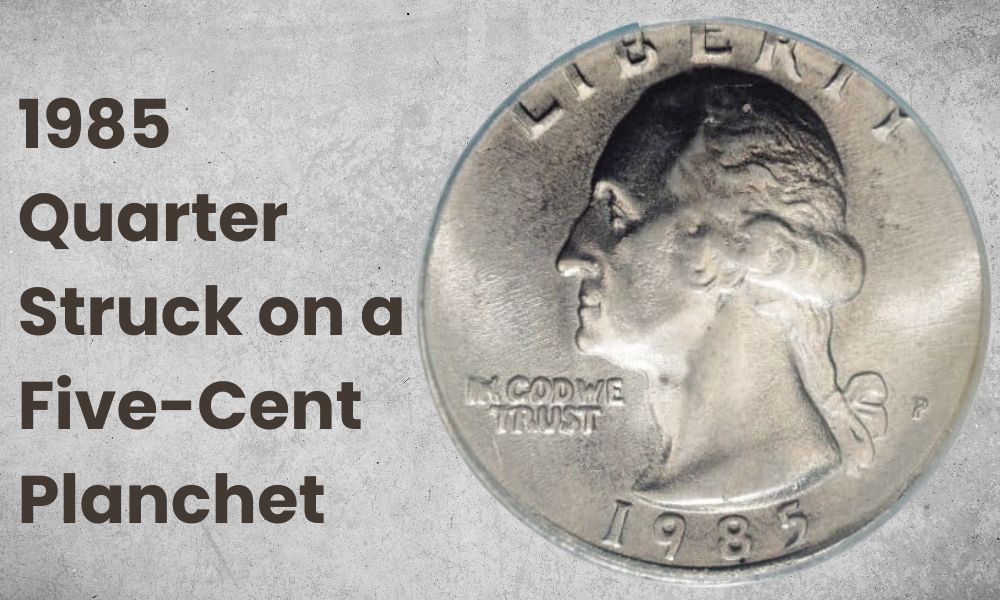
The Philadelphia mint has manufactured a lot of errors, such as this one. This happens when the die is struck on a different planchet – in this case: one made for a nickel.
This coin – in MS 67 grade – has sold for $305.
6. 1985 Quarter Missing Clad Layer Error
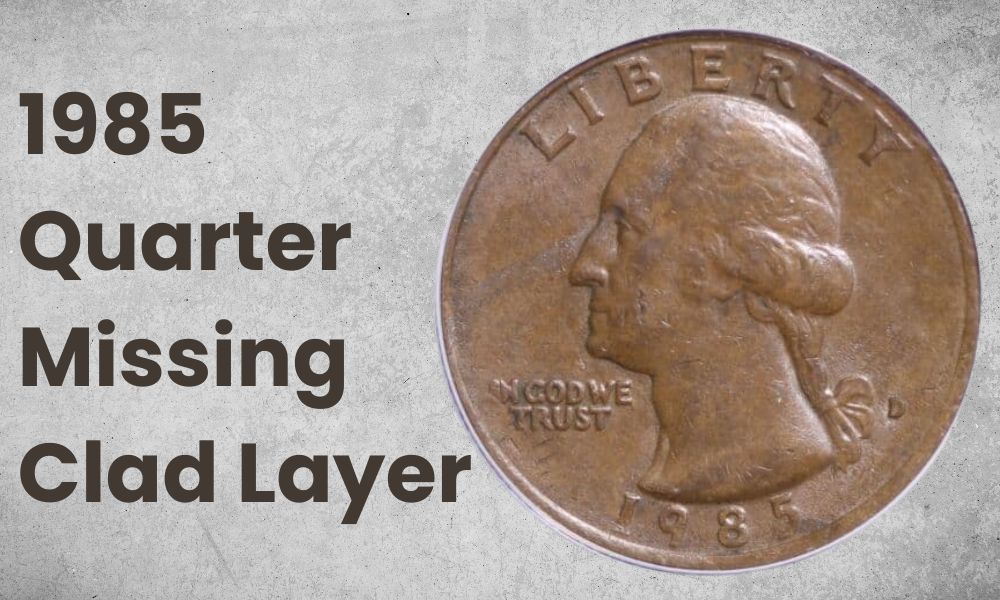
This error occurs when a part of the outer layer is missing from the central core. This might not be noticeable to the untrained eye – unless you weigh the coin. Currencies with this defect often weigh lower than a ‘normal’ coin.
For example, an MS 63 coin with this error only weighs 4.68 grams – when it should weigh 5.67 grams.
It is not as rare as the other mistakes above, so it can only sell for about $59.
Also Read: 10+ Rarest State Quarter Errors Lists (Worth Much Money!!!)
1985 Quarter FAQs
Is a 1985 quarter worth anything?
Yes. A 1985 quarter is worth $10 to $15 uncirculated, while proof coins are worth $4.63.
High-grade coins can sell for $1,323 (P quarter) to $4,250 (D quarter.)
How much is a 1985 D Liberty quarter worth?
The 1985 D quarter is worth $10 uncirculated. Higher-grade coins, such as MS 65 and MS 67, are worth $16 and $550, respectively. MS 68 coins are valued more, for they can be sold for as much as $4,250.
What makes a 1985-P quarter valuable?
A 1985 P quarter is valuable because its high-grade coins are rarer than the D and S quarters. In fact, a 1985 P quarter is worth $15 uncirculated, compared to the D quarter, which is only worth $10.
P quarters also have more mistakes, such as double/multi-strike errors, mated pair errors, etc.
What is the 1985 quarter error?
There are many types of 1985 quarter errors, and here’s how much they cost:
- Missing clad layer error, $79
- Double strike error, from $190 to $280
- Wrong planchet error, $300
- Multi strike error, $800
- Mated pair error, $1,725
Are there any rare 1985 quarters?
1985 quarters in top grades are considered rare. For example, an MS 68 D quarter has sold for $4,250 in an auction.
1985 quarters bearing errors are deemed rare too. Take the case of the mated pair quarters, which sold for $1,725 at auction.
What should I look for in a 1985 quarter?
As coins with errors are valued higher, you should try to look for such mistakes in your currency. Double/multiple strikes, wrong planchet errors, and mated pair errors cost anywhere from $190 to $1,275.
You should also make it a point to weigh your coins, for a missing clad layer error may be unnoticeable – unless you determine its weight.
